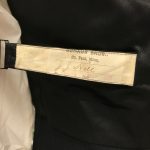Welcome to the exhibition page for When Home Won’t Let You Stay: Art and Migration. Here is the introductory text on artsmia.org:
“When Home Won’t Let You Stay: Art and Migration” considers how contemporary artists are responding to the migration, immigration, and displacement of people today. The world is currently witnessing the highest levels of movement on record—the United Nations estimates that one out of every seven people in the world is an international or internal migrant who moves by choice or by force, with great success or great struggle.
Through artworks made since 2000 by 20 artists from countries such as Colombia, Cuba, France, India, Iraq, Mexico, Morocco, Nigeria, Palestine, South Korea, the United Kingdom, and the United States, this exhibition highlights diverse artistic responses to migration. Ranging from personal accounts to poetic meditations, the artwork features a range of mediums, including sculpture, installation, painting, and video.”
Here are the FINAL labels and panels:
WHWLYS_Labels_02.12.20 final
Art and Migration text for Docents and Guides
Here is the gallery map (though the smaller flag of Pangea (Tania Bruguera) is not included in the exhibition:
Gallery map_A&M
Teacher’s Guide and Deep Dive (same content):
Mia_WHWLYS_TeacherGuide_Final
Mia_WHWLYS_Guide_DeepDive_Final
Here is a link to the video of Gabe Ritter’s lecture on February 6:
Art & Migration lecture video
Gabe’s PowerPoint:
GRitter_ArtMigration_TRAINING
(Concerning the map Gabe used in discussing Kallat’s Woven Chronicle, here is the map’s key:
RED: Industrialized (Manufacturing and services) High income economies
ORANGE: Newly industrialized (Manufacturing and mining) Upper middle income economies
BLUE: Industrializing (Mining industry–oil and mineral) Upper middle income economies
BROWN: Industrializing (Agriculture predominates) Middle income economies
YELLOW: Agricultural, low income economies
GREY: No data
Additional labels and curatorial information from Gabe Ritter:
Art and Migration DOCENT MATERIAL1 Mia specific installations
GRitter_Migration_AllStaff_notes
Ritter_Curatorial Statement Feb. 6_TO EDITOR
Materials from the February 17 FOH cultural fluency training:
VIDEO of the February 17 cultural fluency training
Jack DeWaard PPT slides Feb. 17
Art and Migration VETT PPT 2-16-20
Art and Migration Fact Sheet CONDENSED
Top 5 FAQ WHWLYS
From our Learning Innovation Fellow Tamira Amin, her article on How climate change and colonialism are spurring mass migration: The violent roots of today’s unprecedented displacement.
Local and national media on exhibition
KARE 11 interview with Gabe Ritter about the Ai Weiwei installation (video): Minneapolis Art Institute’s latest exhibit features thousands of life jackets worn by refugees
From Bruce Robbins, an article in the Pioneer Press: Thousands of life jackets…
Review of exhibition in the Strib: For exhibit about migration, Minneapolis museum wraps its white facade in colorful life jackets
Minneapolis Institute of Art opens a provocative exhibition.
A PBS Newshour story on the exhibition while in Boston from your colleague Barb Horlbeck: Memory, meaning and mortality at heart of migration exhibit
Peer suggestions for additional information:
From your colleague Kathleen Steiger, a book recommendation: Author Isabel Allende’s new book – Long Petal to the Sea tells an engrossing story of Refugees fleeing Spain and then Chile starting 80 years ago. She has been interviewed on PBS News hour but this one from a recent Amanpour show is longer and more in depth.
https://www.pbs.org/video/isabel-allende-immigration-loss-and-her-new-novel-cyzxrz/
From Shelly McGinnis, a really great conversation about immigrants & belonging: Flyover 2020: What does patriotism mean? (MPR News)
From Rose Stanley-Gilbert: an overview of the history of US Migration as background for touring. I thought some might want to pick and choose a few facts to give historical perspectives to their tour. This is pretty concise for a complex subject: Immigration Timeline
From Kathleen Steiger: This was just rebroadcast and it is great. A history of Landscape Painting starting with 10th century Chinese works and including Misrach (in the Migration exhibit). (TPT link here)
From many of you, an excellent interview with Kerri Miller: Author Dina Nayeri on breaking down stereotypes of the refugee experience
From Lynn Dunlap, a plethora of video resources!
Ai Weiwei drifting – art, awareness and the refugee crisis | DW Documentary
Carlos Motta – The Crossing
Artist Talk: Richard Mosse
Opening Exhibition Lecture » Richard Misrach on Border Cantos
Artists Take On Global Migration: ‘It’s Hard To Watch And It’s Hard Not To Watch’ (Kader Attia)
Rineke Dijkstra: Almerisa Series
From Margo Squire, a story on the current conditions on Lesbos: Migrants wait in bread lines while tourists dine on grilled octopus
From Manju Parikh, a POV public TV documentary (available in the library system): ” Well Founded Fear”. It was shown on POV (Point of View) series on Public TV on 2000. Description on DVD: (Immigrants apply for political asylum with the I.N.S. in pre-9/11 America.)
From Jan Lysen, What’s happening at the U.S.-Mexico border in 5 charts
and Measuring illegal immigration: How Pew Research Center counts unauthorized immigrants in the U.S.
